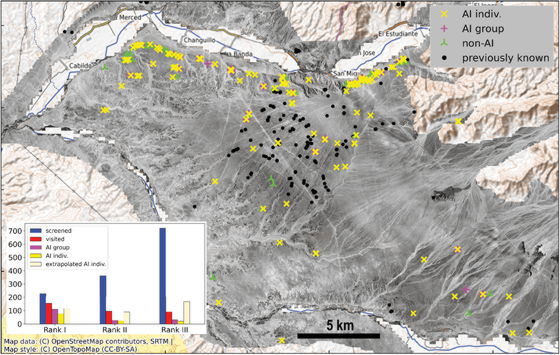Yamagata University succeeds in discovering 303 Nazca lines in six months using AI, revealing the purpose of the lines

A joint research project between Yamagata University's Nasca Institute and IBM Research has reported that they have discovered 303 new lines in a six-month field survey of Nasca using AI, nearly doubling the number of lines already identified on the Nasca Plateau.
AI accelerates Nazca exploration, nearly doubling the number of known figurative lines and revealing their purpose | Latest News: Press Release | Yamagata University
AI-accelerated Nazca survey nearly doubles the number of known figurative geoglyphs and sheds light on their purpose | PNAS
https://www.pnas.org/doi/full/10.1073/pnas.2407652121
Hundreds of Mysterious Nazca Glyphs Have Just Been Revealed : ScienceAlert
https://www.sciencealert.com/hundreds-of-mysterious-nazca-glyphs-have-just-been-revealed
On the flat desert surface surrounded by the Nazca and Ingenio rivers in Peru, geometric figures and pictures of plants and animals are drawn by color-coding the gravel. These are called the Nazca Lines and were first discovered in the 1920s. Research to date has confirmed 430 figurative lines among the Nazca Lines, and new ones continue to be discovered at the time of writing.
Yamagata University opened the Nasca Institute in 2012 to study the geoglyphs, and is one of the few research institutions authorized to conduct on-site surveys. The Nasca Institute has discovered 318 of the 430 figurative geoglyphs that have been discovered using remote sensing technology (satellites, aircraft, and drones), but because the Nasca Plateau is a vast area of approximately 400 square kilometers, it was difficult in terms of time to visually inspect all of the high-resolution aerial photographs and conduct on-site surveys.
To solve this problem, the Nazca Institute is working with IBM to identify geoglyphs using AI. The Nazca Institute and IBM's AI-based geoglyph discovery project reported discovering 143 undiscovered geoglyphs in 2019.
IBM's AI succeeds in finding undiscovered 'Nazca Lines', 143 lines found look like this - GIGAZINE

The joint research project between the Nazca Institute and IBM has continued to discover new geoglyphs since then, and a new paper reports that it has discovered 303 new figurative geoglyphs in just six months. By using IBM's AI, the rate of discovery of geoglyphs has increased by 16 times, and in particular, a large number of 'face-type figurative geoglyphs' have been discovered.
The challenge with AI used to discover geoglyphs is the limited amount of training data. IBM has succeeded in developing a powerful AI model that performs well even with a small amount of training data, making it possible to identify areas where geoglyphs are likely to exist. By examining an average of 36 candidates for geoglyphs presented by the AI model, the team was able to find one candidate site where a geoglyph is likely to exist. The research team reported that this is a groundbreaking achievement in this type of work. In addition, the research team identified a total of 1,309 promising candidate sites, and conducted field surveys of about a quarter of them, resulting in the discovery of 303 new concrete geoglyphs in just six months.
Below is a map showing 'places with a high probability of existence of geoglyphs' predicted using AI. Places with a high probability of existence of geoglyphs are divided into three ranks, with 'Rank I' being the place with the highest possibility of existence of a geoglyph and 'Rank III' being the candidate site with the lowest probability. The places shown in red are the places where we were able to conduct field surveys.

Below is a map showing the locations where new geoglyphs were discovered during field surveys. Known geoglyphs are marked in black, new geoglyphs discovered in areas where AI predicted that geoglyphs were likely to exist are marked in yellow, parts of groups where AI predicted that geoglyphs exist are marked in purple, and areas where AI predicted that geoglyphs exist but no geoglyphs were found during field surveys are marked in green.

The following image is a compilation of 15 of the 303 newly discovered ground drawings using AI. The ground drawings were photographed on-site using a drone. To make it easier to understand what the ground drawings are like, the outlines are drawn in white, and the white line drawn under the ground drawings is a 5-meter scale bar. The ground drawings include human figures, heads, livestock (camelidae), killer whales, birds, cats, ritual scenes, and human-animal interactions.

The team classified the newly discovered geoglyphs and trails. The trails were divided into meandering paths and formal roads, and the geoglyphs into geometric and figurative. The geoglyphs were further divided into linear and area types. Area types were found to differ from linear types in style, scale, and distribution, and also in motifs.
The area-type geoglyphs are distributed along a network of straight lines and trapezoids, while the line-type geoglyphs are distributed along winding paths. The paper also reports that the linear figurative geoglyphs were created for community rituals, while the area-type geoglyphs are like 'bulletin boards' visible from the paths, and were created mainly to share activities related to livestock and heads.
Related Posts:
in Science, Posted by logu_ii






